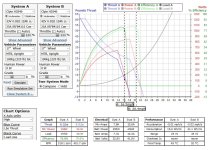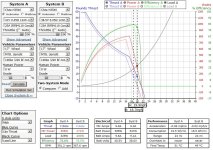flippy said:
this is the actual issue for most people on this forum. they are doing a battery build based only on maximizing capacity and volume with low weight and then just take cell ratings as "more of a guide" instead of actual limits and then start complaining when shit starts exploding, leaking or have a lifespan of a carton of milk on a parking lot in mid summer in downtown Phoenix and genuinely act suprised when their pack has died after a single season.
the idea that lowering voltages will do anything meaningful when killing cells in this manner is not one that should be entertained as it gives a impression that people can abuse cells -but its fine because i stop charging at 4.1v-.
its basically filling up a gas tank halfway but constanty drive at the rpm limiter and thinking the engine will last longer with only half a tank.
how true!

:thumb:
Pajda said:
Of course, but the main problem, which I am talking about is the level of deterioration at "higher" voltages. DrkAngel I have problem with the graphs in the first post of your thread. It is just higly missleading for for the casual reader. I repeat over and over that it is just bullshit that you kill the modern 18650 cells (it means almost all cells produced after 2012) in just 400-500 cycles when you use 100% DoD with 4.2V charging voltage. Many people, which I talked to, is OK with 1000 cycles or 5 years life but they simply thought, based on this "university" articles, that for achieving that it is absolutely necessary to use 70% or lower SoC window.
Scientific articles are aimed to find the absolute values of wear level and they did not comment what this implies for the average use case. If I use as example the cell from the article, which you are posted, or the data from EVE. Both are clearly showing that there are existing cells which can do easily 1000 equivalent full cycles with 4.2V charging voltage and high DoD. So I am only adding my comment to this results: If you choose to charge your battery to 4.1V or lower per cell, the benefit of doing that will be shown in average traction app no more than after 4-5 years or 700-1000 cycles (calendar ageing included) for many modern high quality 18650 cell. And so one should think that for this whole time you will suffer with the bigger, heavier and more expensive battery with lower range.
That is all from me to this topic. :thumb:
Hi Pajda,
i have the meaning that we should differentiate between the cylce life of
one single cell, and the lifetime of
larger packs build of dozend or hundred of cells.
It is true that tests are showing that the benefit of charging to only 4,1V will be shown not before some years or hundreds of cycles (in terms of energy that could have been used compared to a full charge), but they normally are referring to one single cell as far as i could see, right? Please correct me if i am wrong.
The problem is that there is one layers in a LiIon cell (Graphite and Silicon on Anode) which does change it's size or volume during charge and discharge. This layer does expand during charge and it shrinks during discharge which could lead to internal damage the more often this happens. Internal damage which could show in small short circuits between the layers and higher self discharge.
Thats not a big problem if one cell from your flashlight or e-cig did suffer this, you probably will replace it without thinking too much about it, but it will be a problem once you have larger packs with one or more cells like this. Even if you have a good BMS and all cells always kept at same voltage, i believe that each cell has it's "own life" or "behaviour" in terms of that.
I have processed thousands of 18650 cells, mostly to repair ebike batteris from Bosch, BionX etc, but to speak about the ones which were custom made and which are used in my near field by friends, i can say the following:
Those which got charged to 100%, or where the charger was set to 4,2V, are practically dead after around two years or 5000km due to aweful high self discharge of a few cells (these numbers are from a 20s9p Samsung 30Q pack for instance), while the ones which are charged to only 4,1V are still fine after many years and show no drift.
When the first 18650 LiIon cells came out, the max charge voltage always was 4,1V. I remember that RC charger which had 4,2V for LiPo and 4,1V for LiIon as fixed CV cut off.
I think the big companies (ebikes, power tools etc) have nothing against that sort of "planned obsolescence" because they can sell a new pack to you every few years, while car makers like Tesla and DIY people don't do this for a good reason.





